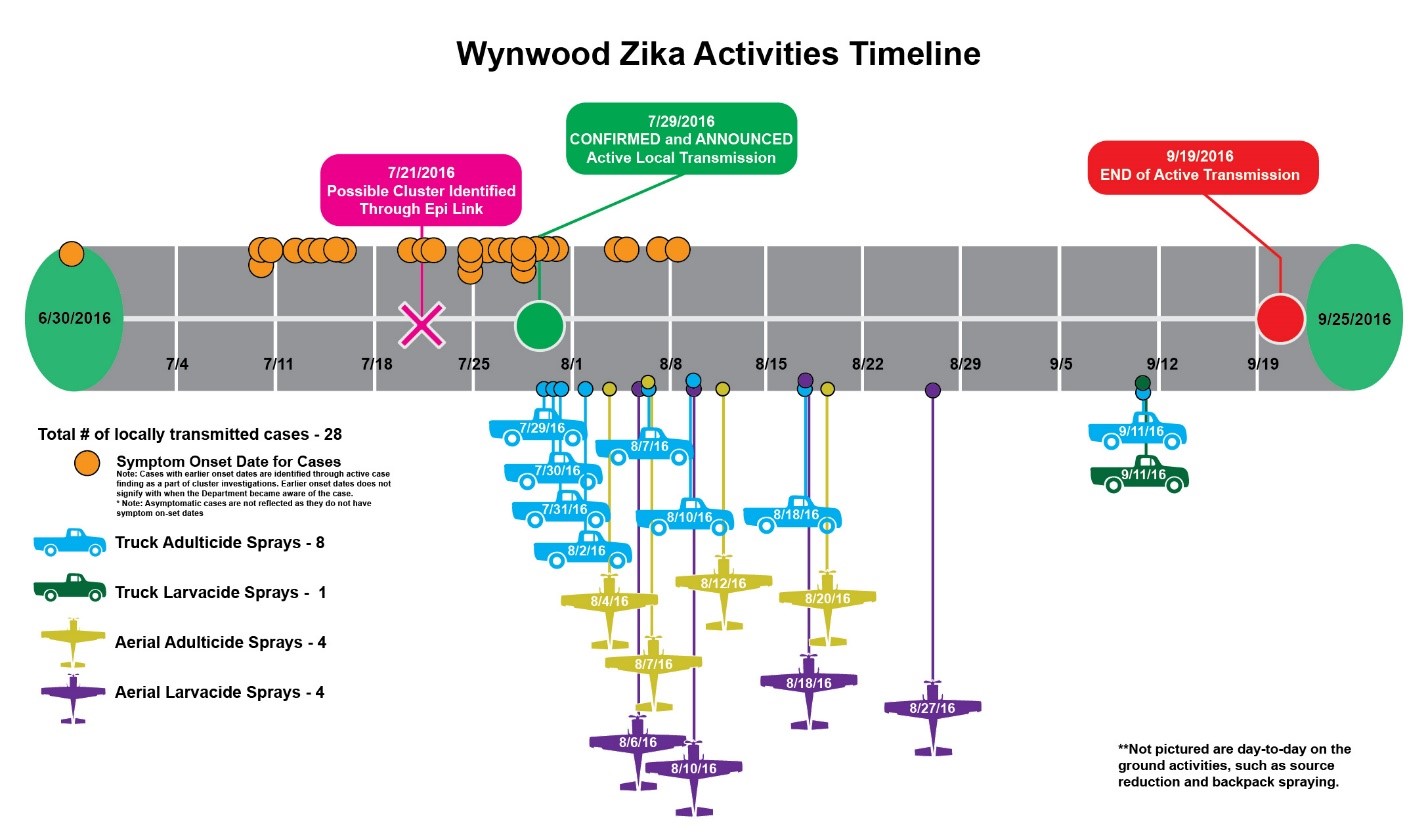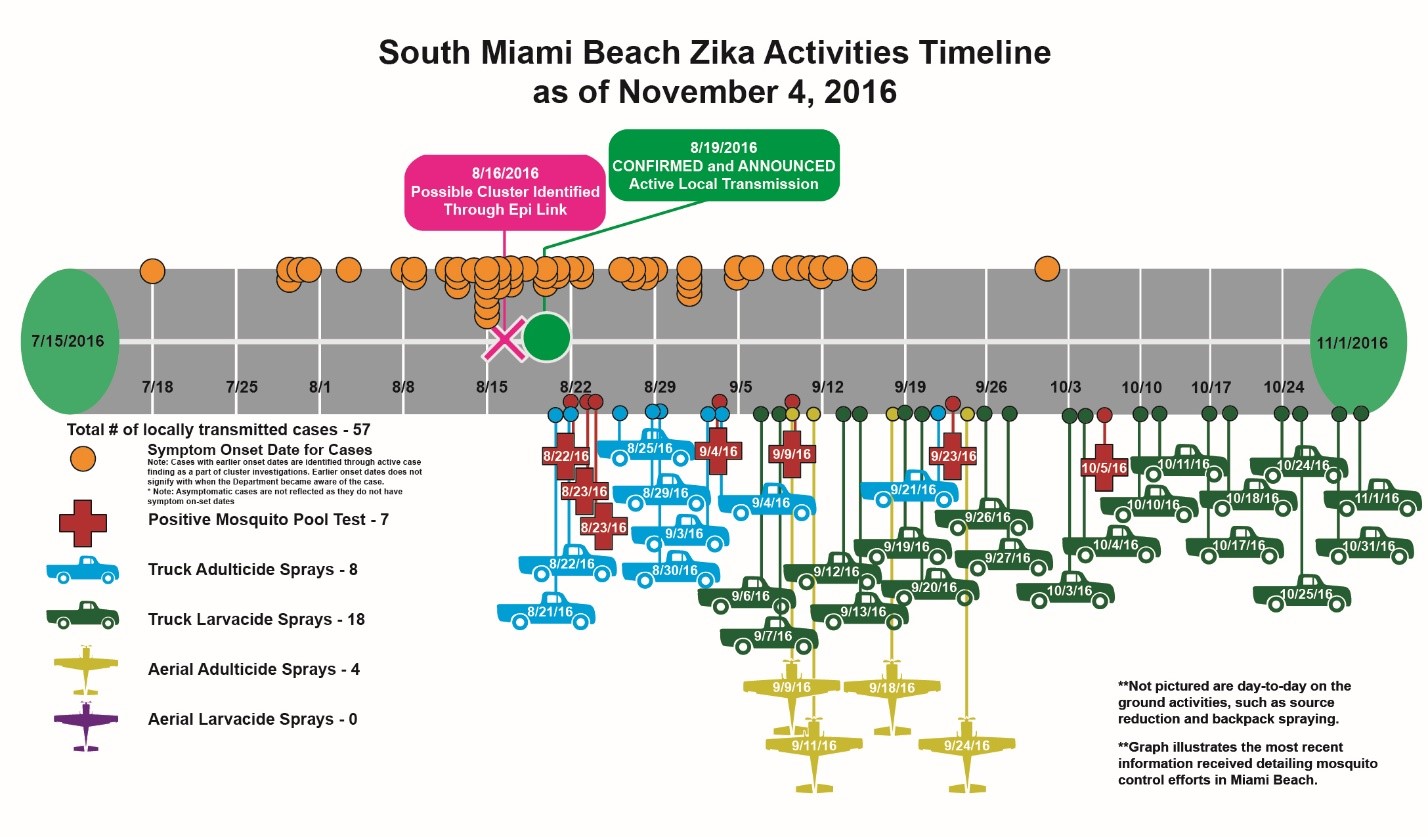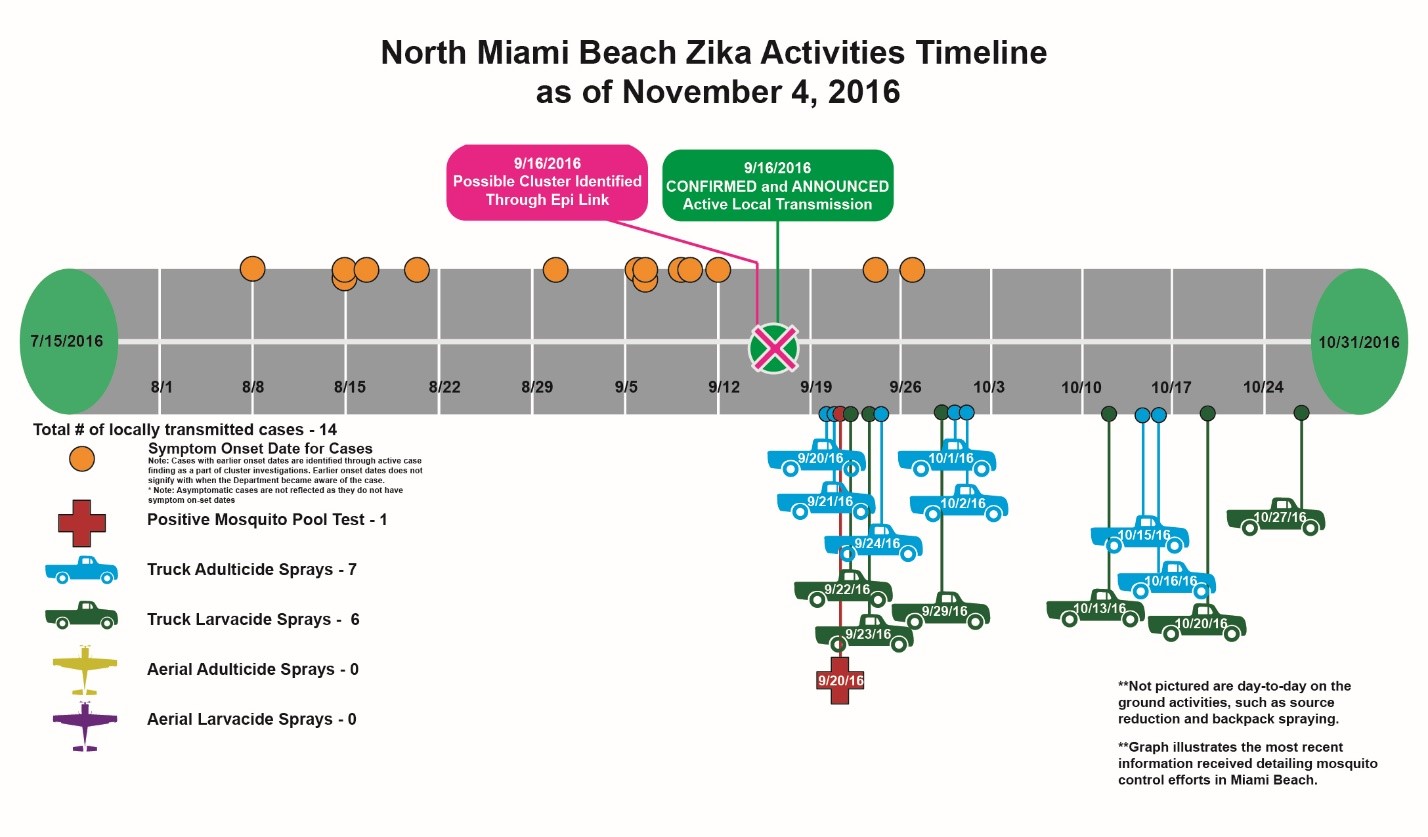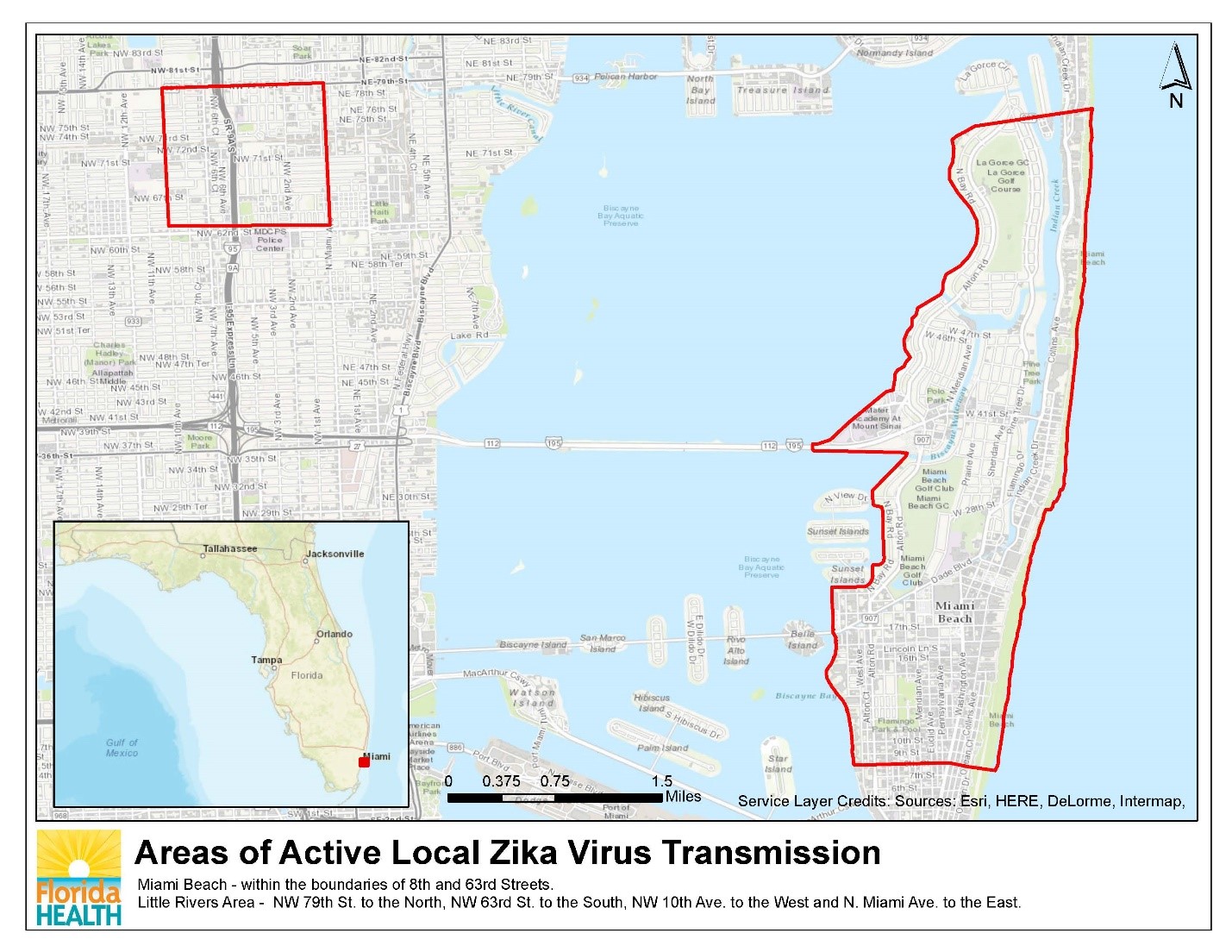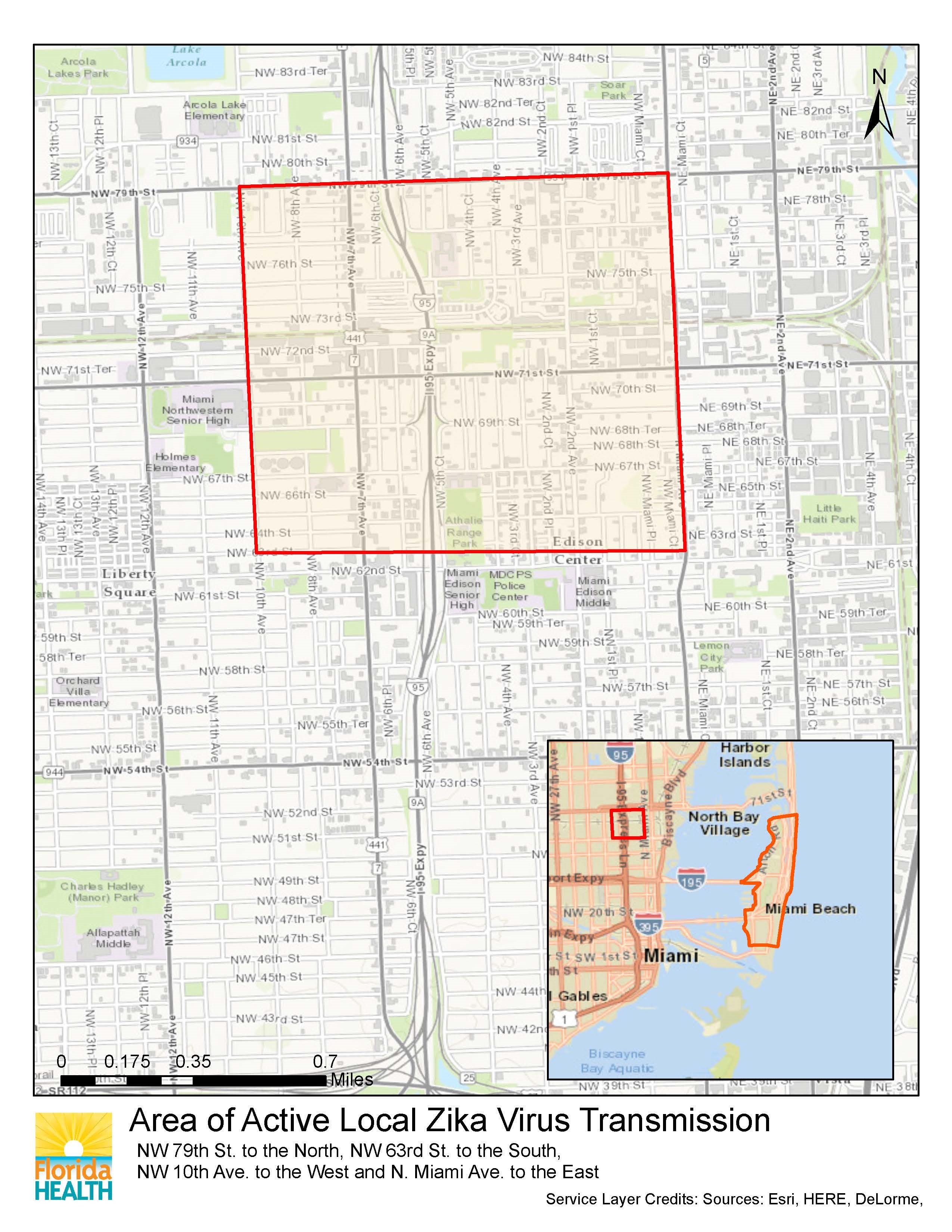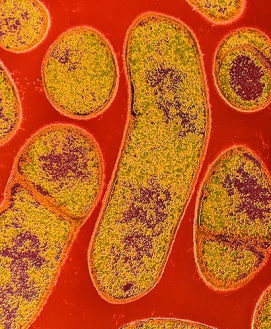Archive for November, 2016
Florida: Zika Update
Saturday, November 12th, 2016November 11, 2016
Department of Health Daily Zika Update
Tallahassee, Fla. — In an effort to keep Florida residents and visitors safe and aware about the status of the Zika virus, the department will issue a Zika virus update each week day. Updates will include a Zika case count by county and information to keep Floridians informed and prepared. In order to keep the public informed, the department has posted our investigation process here.
There are seven new travel-related cases today with four in Broward, two in Miami-Dade and one in Palm Beach.
There are two new locally acquired cases today. Both cases are associated with the Miami Beach investigation. One individual is a Florida resident and the other is a non-Florida resident.
The total number of Zika cases reported in Florida as of today is 1,158.
|
Infection Type |
Infection Count |
|
Travel-Related Infections of Zika |
922 |
|
Locally Acquired Infections of Zika |
224 |
|
Undetermined |
12 |
|
|
|
|
Pregnant Women with Lab-Evidence of Zika |
147 |
Note, these categories are not mutually exclusive and cannot be added together. Please visit our website to see the full list of travel-related cases by county.
DOH continues door-to-door outreach and targeted testing in Miami-Dade counties and mosquito abatement and reduction activities are also taking place around the locations that are being investigated. DOH believes ongoing transmission is only taking place within the identified area in Miami Beach in Miami-Dade County, see map below.
One case does not mean ongoing active transmission is taking place. DOH conducts a thorough investigation by sampling close contacts and community members around each case to determine if additional people are infected. If DOH finds evidence that active transmission is occurring in an area, the media and the public will be notified.
The timelines below are as of Nov. 4. Due to the Veterans Day Holiday, the timelines will be updated on Monday. Note: asymptomatic cases are not reflected as they do not have symptom on-set dates.
The department is currently conducting 14 active investigations. The department has closed 35 investigations. Information regarding the investigations can be found here. If investigations reveal additional areas of active transmission, the department will announce a defined area of concern.
The department has conducted Zika virus testing for more than 10,162 people statewide. Florida currently has the capacity to test 6,878 people for active Zika virus and 5,650 for Zika antibodies. At Governor Scott’s direction, all county health departments now offer free Zika risk assessment and testing to pregnant women.
Florida’s small case cluster is not considered widespread transmission, however, pregnant women are advised to avoid non-essential travel to the impacted area in Miami-Dade County (see map below). If you are pregnant and must travel or if you live or work in the impacted area, protect yourself from mosquito bites by wearing insect repellent, long clothing and limiting your time outdoors.
According to CDC guidance, providers should test all pregnant women who lived in, traveled to or whose partner traveled to Miami-Dade County after Aug. 1, 2016. It is also recommended that all pregnant women who reside in or travel frequently to the area where active transmission is likely occurring be tested for Zika in the first and second trimester. Pregnant women in the identified area can contact their medical provider or their local county health department to be tested and receive a Zika prevention kit. CDC recommends that a pregnant woman with a history of Zika virus and her provider should consider additional ultrasounds. Additionally, the department is working closely with the Healthy Start Coalition of Miami-Dade County to identify pregnant women in the impacted areas to ensure they have access to resources and information to protect themselves. CDC recommends that a pregnant woman with a history of Zika virus and her provider should consider additional ultrasounds.
Pregnant women can contact their local county health department for Zika risk assessment and testing hours and information. A Zika risk assessment will be conducted by county health department staff and blood and/or urine samples may be collected and sent to labs for testing. It may take one to two weeks to receive results.
Florida has been monitoring pregnant women with evidence of Zika regardless of symptoms. The total number of pregnant women who have been or are being monitored is 147.
On Feb. 12, Governor Scott directed the State Surgeon General to activate a Zika Virus Information Hotline for current Florida residents and visitors, as well as anyone planning on traveling to Florida in the near future. The hotline, managed by the Department of Health, has assisted 7,258 callers since it launched. The number for the Zika Virus Information Hotline is 1-855-622-6735.
The department urges Floridians to drain standing water weekly, no matter how seemingly small. A couple drops of water in a bottle cap can be a breeding location for mosquitoes. Residents and visitors also need to use repellents when enjoying the Florida outdoors.
For more information on DOH action and federal guidance, please click here.
For resources and information on Zika virus, click here.
MERS-CoV cluster in Saudi Arabia
Saturday, November 12th, 2016Disease outbreak news
11 November 2016
Between 15 and 29 October 2016 the National IHR Focal Point of Saudi Arabia reported thirteen (13) additional cases of Middle East Respiratory Syndrome (MERS) including four (4) fatal cases.
A MERS outbreak has affected a hospital in Hofouf city, Al Ahssa Region. Four (4) cases are associated with this hospital outbreak. These cases are:
- A 73-year-old male reported to WHO on 15 October (believed to be the index case, see case number 13 below).
- A 33-year-old female reported to WHO on 17 October (see case number 12 below).
- A 61-year-old male reported to WHO on 21 October (see case number 7 below).
- A 55-year-old male reported to WHO on 23 October (see case number 4 below).
One additional case is also associated with the index case but not with the hospital outbreak. This case is a 40-year-old male reported to WHO on 21 October (ambulance driver who transferred the index case before he was identified as a MERS case and isolated, see case number 6 below).
A Rapid Response Team was dispatched and extensive contact tracing was initiated. A total of 27 healthcare contacts and 14 patients in the hospital were traced. Elective admissions have been suspended at the center, and necessary prevention and control measures put in place.
Details of the cases
- A 41-year-old male national living in Buridah city, Qassim Region. He developed symptoms on 12 October and was admitted to hospital on 27 October. The patient who has comorbidities tested positive for MERS-CoV on 28 October. Investigation of history of exposure to the known risk factors is ongoing. Currently the patient is in critical condition admitted to ICU but not on mechanical ventilation.
- A 65-year-old male non-national living in Arar city, Northern border Region. He developed symptoms on 24 October and was admitted to hospital on 25 October. The patient who has no comorbidities, tested positive for MERS-CoV on 26 October. He is one of the household contacts of the 58-year-old MERS case reported to WHO on 23 October (see case number 5 below) and was identified through tracing contacts. Currently the patient is in stable condition admitted to a negative pressure room on a ward.
- A 46-year-old male non-national living in Hofouf city, Al Ahssa Region. He developed symptoms on 18 October and was admitted to hospital on 22 October. The patient who has comorbidities, tested positive for MERS-CoV on 23 October. He had a history of contact with camels and their raw meat in the 14 days prior to the onset of symptoms. Currently the patient is in stable condition admitted to a negative pressure room on a ward. Ministry of Agriculture was informed and investigation of camels is ongoing.
- A 55-year-old male non-national works living in Hofouf city, Al Ahssa Region. He was admitted to the hospital, currently affected by the MERS outbreak, due to myocardial infarction on 2 October. On 20 October, while hospitalized, he developed symptoms and tested positive for MERS-CoV on 22 October. Investigation of possible epidemiological link with the MERS cases detected in the same hospital is ongoing. The patient was in critical condition admitted to ICU. He passed away on 22 October.
- A 58-year-old male non-national works living in Arar city, Northern border Region. He developed symptoms on 14 October and was admitted to hospital on 20 October. The patient who has comorbidities tested positive for MERS-CoV on 22 October. Investigation of history of exposure to the known risk factors is ongoing. The patient was in critical condition admitted to ICU but not on mechanical ventilation. He passed away on 27 October.
- A 40-year-old male national living in Uaryarah city, Eastern Region. He developed symptoms on 19 October and was admitted to hospital on 20 October. The patient who has no comorbidities tested positive for MERS-CoV on 21 October. On 13 October, he transported the 73-year-old MERS case reported to WHO on 15 October (see case number 13 below) by an ambulance to the hospital, currently affected by the MERS outbreak before the case was identified and isolated. Currently the patient is in stable condition in home isolation.
- A 61-year-old male national living in Hofouf city, Al Ahssa Region. He was admitted to the hospital currently affected by the MERS outbreak on 13 October for catheterization. On 14 October, he developed symptoms while hospitalized. The patient tested positive for MERS-CoV on 20 October. Investigation of possible epidemiological link with the MERS cases hospitalized in the same hospital is ongoing. Currently the patient is in stable condition admitted to a negative pressure isolation room on a ward.
- A 72-year-old female national living in Najran city, Najran Region. She developed symptoms on 13 October and was admitted to hospital on 16 October. The patient who has comorbidities tested positive for MERS-CoV on 20 October. Investigation of history of exposure to the known risk factors is ongoing. Currently the patient is in stable condition admitted to a negative pressure isolation room on a ward.
- A 53-year-old male national living in Abha city, Assir Region. He developed symptoms on 9 October and was admitted to hospital on 19 October. The patient who has comorbidities tested positive for MERS-CoV on 20 October. Investigation of history of exposure to the known risk factors is ongoing. The patient was in critical condition admitted to ICU but not on mechanical ventilation. He passed away on 22 October.
- A 47-year-old male non-national living in Buridah city, Qassim Region. He developed symptoms on 10 October and was admitted to hospital on 15 October. The patient who has no comorbidities tested positive for MERS-CoV on 17 October. He has a history of contact with camels and consumption of their raw milk in the two weeks prior the onset of symptoms. Currently the patient is in stable condition admitted to a negative pressure isolation room on a ward. Ministry of Agriculture was informed and investigation of camels is ongoing.
- A 72-year-old male national living in Riyadh city, Riyadh Region. He developed symptoms on 13 October and was admitted to hospital on 17 October. The patient who has comorbidities tested positive for MERS-CoV on 17 October. Investigation of history of exposure to the known risk factors is ongoing. Currently the patient is in critical condition admitted to ICU on mechanical ventilation.
- A 33-year-old female non-national in the hospital, currently affected by the MERS outbreak and living in Hofouf city, Al Ahssa Region. She is asymptomatic but identified through tracing contacts of the 73-year-old male MERS case reported to WHO on 15 October (see case number 13 below). The patient who has no comorbidities tested positive for MERS-CoV on 15 October. Currently she is in stable condition in home isolation.
- A 73-year-old male national living in Hofouf city, Al Ahssa Region. He developed symptoms on 10 October and was admitted to the hospital, currently affected by the MERS outbreak on 13 October. The patient who has comorbidities tested positive for MERS-CoV on 14 October. He has a history of contact with camels and consumption of their raw milk in the 14 days prior to the onset of symptoms. The patient was in stable condition admitted to a negative pressure isolation room on a ward but his conditions deteriorated and he passed away on 18 October. Ministry of Agriculture was informed and their investigation is ongoing.
Contact tracing of household and healthcare contacts is ongoing for these cases.
Globally, since September 2012, WHO has been notified of 1826 laboratory-confirmed cases of infection with MERS-CoV including at least 649 related deaths have been reported to WHO.
WHO risk assessment
The current health care associated cases reported are not changing the overall risk assessment but are underlying the need for continued surveillance and application of Infection prevention and control measures.
MERS-CoV causes severe human infections resulting in high mortality and has demonstrated the ability to transmit between humans. So far, the observed human-to-human transmission has occurred mainly in health care settings.
The notification of additional cases does not change the overall risk assessment. WHO expects that additional cases of MERS-CoV infection will be reported from the Middle East, and that cases will continue to be exported to other countries by individuals who might acquire the infection after exposure to animals or animal products (for example, following contact with dromedaries) or human source (for example, in a health care setting). WHO continues to monitor the epidemiological situation and conducts risk assessment based on the latest available information.
WHO advice
Based on the current situation and available information, WHO encourages all Member States to continue their surveillance for acute respiratory infections and to carefully review any unusual patterns.
Infection prevention and control measures are critical to prevent the possible spread of MERS-CoV in health care facilities. It is not always possible to identify patients with MERS-CoV early because like other respiratory infections, the early symptoms of MERS-CoV are non-specific. Therefore, health-care workers should always apply standard precautions consistently with all patients, regardless of their diagnosis. Droplet precautions should be added to the standard precautions when providing care to patients with symptoms of acute respiratory infection; contact precautions and eye protection should be added when caring for probable or confirmed cases of MERS-CoV infection; airborne precautions should be applied when performing aerosol generating procedures.
Until more is understood about MERS-CoV, people with diabetes, renal failure, chronic lung disease, and immunocompromised persons are considered to be at high risk of severe disease from MERS-CoV infection. Therefore, these people should avoid close contact with animals, particularly camels, when visiting farms, markets, or barn areas where the virus is known to be potentially circulating. General hygiene measures, such as regular hand washing before and after touching animals and avoiding contact with sick animals, should be adhered to.
Food hygiene practices should be observed. People should avoid drinking raw camel milk or camel urine, or eating meat that has not been properly cooked.
WHO does not advise special screening at points of entry with regard to this event nor does it currently recommend the application of any travel or trade restrictions.
Wilson County, NC & Hurricane Matthew: The Aftermath
Saturday, November 12th, 2016
Nov 10, 2016
By Olivia Neeley
The Wilson Daily Times
- More than 530 Wilson County residents registered with the Federal Emergency Management Agency for assistance after Hurricane Matthew
- The 530-plus individuals FEMA assisted received more than $640,000 disbursement in funds countywide.
- The 911 Communications Center received 2,500 calls for service over the three-day period during and after Hurricane Matthew.
- There were roughly 230 water rescues performed during the height of the storm, most of which were vehicles rescues and getting people out of houses that were threatened by water.
- Two people were also killed in Wilson County as a result of moving water in the roadways. Their vehicles were swept away.
Remininces: An American at WTC on 9/11 and at the Bataclan Night Club during the Paris terror attack (11//13/15)
Saturday, November 12th, 2016‘……”I remember more screams, the smell of blood, but I also remember being insanely focused on getting out and things moving agonizingly slow.”……..’
Nigeria: WHO and health partners helped vaccinate more than 10 000 children against measles in 2 days in internally displaced persons (IDP) camps in the conflict-affected Borno State.
Friday, November 11th, 2016- “…Since 6 June 2016, health clinics in IDP camps in Borno State have seen increasing numbers of measles cases. From early September until late October, 744 suspected cases of measles, and 2 deaths, were reported from WHO-established EWARS reporting sites. The majority of these children had never been vaccinated against measles and most of them were aged less than 5 years….”
Key facts
- Measles is one of the leading causes of death among young children even though a safe and cost-effective vaccine is available.
- In 2015, there were 134 200 measles deaths globally – about 367 deaths every day or 15 deaths every hour.
- Measles vaccination resulted in a 79% drop in measles deaths between 2000 and 2015 worldwide.
- In 2015, about 85% of the world’s children received one dose of measles vaccine by their first birthday through routine health services – up from 73% in 2000.
- During 2000-2015, measles vaccination prevented an estimated 20.3 million deaths making measles vaccine one of the best buys in public health.
The Global Burden of Disease: Air pollution is the fourth top cause of death globally, after poor diet, high blood pressure and smoking.
Friday, November 11th, 2016- “In December 1873, London was blanketed for a week in a yellow fog so thick that people could not see their feet. Some 780 people died.
- “…..roughly 6.5 million people died from both indoor and outdoor air pollution in 2015. Two million of them died in India. Deaths from outdoor air pollution have risen to 4.2 million in 2015 from 3.5 million in 1990…..”
- “….In England…in 1952…..another heavy smog episode — this time from coal-burning fireplaces and cooking ranges — left as many as 12,000 dead…..”


